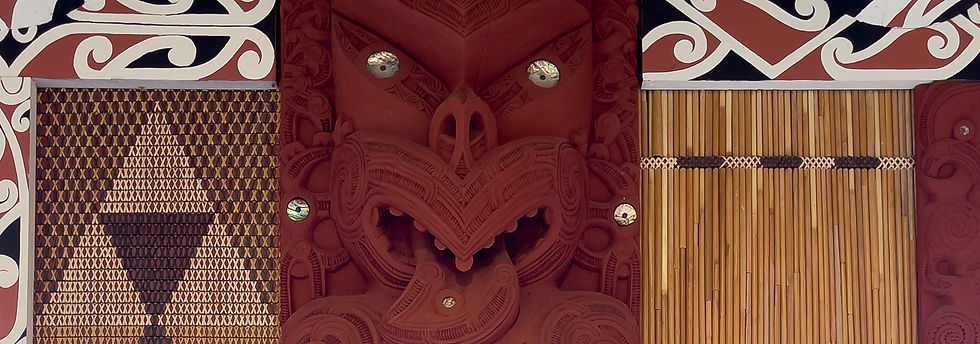
Hikairo is thought to have been born in the late eighteenth century, probably between 1780 and 1790, probably at Puhirua or Te Awahou, on the northern shores of Rotorua. He became leader of Ngāti Rangiwewehi, one of the largest Te Arawa sub-tribes, and was prominent from about 1806.
Hikairo was descended from famous ancestors, Rangitihi and Uenukukōpako. Through his father, Whēkiki, he was descended from Rangiwewehi, through Kererū, Wehiwehi, Te Whatu and Te Ngaro, and thus belonged to Ngāti Kererū hapū of Ngāti Rangiwewehi. Hikairo also had connections with Ngāti Pikiao, Tapuika and Tūhoe. His mother was from Ngāti Pūkeko. He was sometimes known as Te Tuatahi-a-Whēkiki, and later as Wiremu (and sometimes Te Wiremu) Hikairo. Little is known of Hikairo's early life. After the arrival of the Church of England missionaries at Te Koutu in 1835, he taught himself to read, and gained considerable knowledge of the Scriptures.
According to Ngāti Rangiwewehi scholar Te Rangikāheke, Hikairo had three wives. Rangikauamo, who was also descended from Rangitihi, was the mother of Te Mete Hikairo, who became known as Wiremu Mita Hikairo when he served as an assessor in the Native Land Court in the 1860s and 1870s. Maea-te-rangi was the mother of another son, Heketoro. Te Apuhau was another wife of Hikairo. Hikairo also had a daughter, Pīnenga, whose mother's name is not recorded. Hēmana Pōkiha states in Ngā mōteatea that Hikairo's wife was Ngārangikamaea, and that she was the mother of Heketoro, Mākari and Mita Hikairo.
About 1806, during fighting between Ngāti Rangiwewehi and Ngāti Whakaue, Hikairo killed Te Kōhuru of Ngāti Whakaue at Weriweri, on the western shore of Rotorua. In response to this killing, another battle took place in which Ngāti Rangiwewehi were defeated. Soon afterwards, peace was made. In 1823, after Hongi Hika of Ngāpuhi had attacked and taken Mokoia, Hikairo and others escaped from the island. Hikairo was related to Te Ao-kapurangi, wife of Te Wera Hauraki of Ngāpuhi, and returned to Mokoia to speak on behalf of his people. In reply, Hongi Hika declared that there would be no more killing, and Ngāpuhi returned home.
In 1832, after Ngāpuhi under Te Haramiti had attacked Tūhua (Mayor Island) and Mōtītī Island, Hikairo attempted to form an alliance of Te Arawa with Ngāi Te Rangi of Tauranga against Ngāpuhi. Other Te Arawa tribes refused, but Ngāti Rangiwewehi joined Ngāi Te Rangi and initially defeated Ngāpuhi.
Hikairo demonstrated his capacity for strategy, and consideration of the long-term interests of his tribe, in the wars resulting from the killing at Parahaki of Te Hunga, a relative of Te Waharoa of Ngāti Hauā, probably by Haerehuka of Ngāti Whakaue in December 1835. Hikairo and Korokai of Ngāti Whakaue prevented Te Arawa hapū from fighting each other. Hikairo sought and won the alliance of Tūhourangi, and planned an attack on Ngāti Hauā allies Ngāi Te Rangi at their pā at Te Tūmū in May 1836. Hikairo attacked at one of the three gateways to the pā, rallying his people by jumping to the fore, grimacing, shouting and singing his war-song. Te Tūmū fell to Te Arawa. Not long afterwards Hikairo made peace between Te Arawa and Waikato, and sealed it with the marriage of his daughter, Pīnenga, to Te Ārahi, the son of Te Waharoa. The possession of Maketū, the important flax-growing area in the Bay of Plenty, remained in contention, however. Although Hikairo took some part in the first stages of the more sporadic warfare which continued into the 1840s, he refused permission to other Te Arawa hapū to cross his land seeking revenge against Ngāi Te Rangi and Waikato in 1839. He thus prevented an immediate attack. In 1841 he made a bold attempt to make peace with Ngāi Te Rangi by talking to them in their pā, but was only partially successful. A conclusive peace was not reached until September 1845.
Hikairo's efforts to maintain peace continued. In July 1845 he called a great meeting at Puhirua. About 800 attended, including visitors from Waikato and Tauranga. Speeches of peace were made, and it was agreed that, to avoid further warfare, any individual who committed murder would be punished. Hikairo plied his guests with liberal hospitality. Catechism and hymns were also an integral part of the gathering. Hikairo called another meeting in 1847 to discuss the murders of Te Mānihera and Kereopa, Ngāti Ruanui Christians, who had been killed near Tokaanu in March. His aim was to prevent such occurrences in the future. In 1848 he pleaded for peace between Ngāti Whakaue and Tūhourangi over a land dispute.
Hikairo had considerable knowledge of Christianity, and its influence is demonstrated in his efforts to make peace. He refused baptism, however, fearing that the conflict with tradition would lead to a loss of his mana in the eyes of contemporary chiefs. He died at Puhirua on 28 October 1851, and is buried in the cemetery on the summit of Ōrangikāhui, near Te Awahou.
Source: https://teara.govt.nz/en/biographies/1h19/hikairo-wiremu




